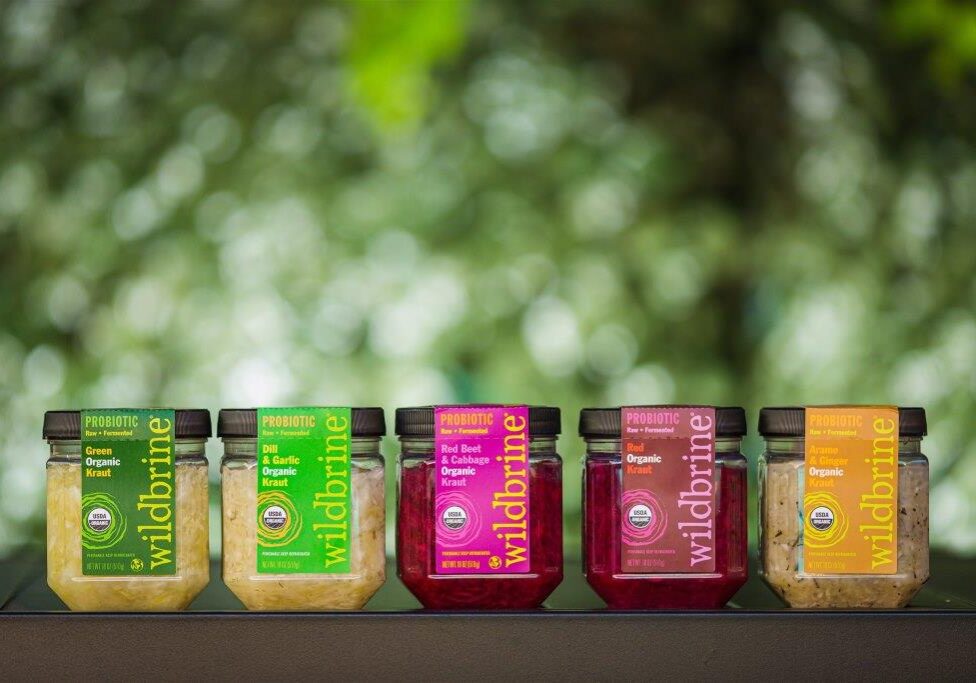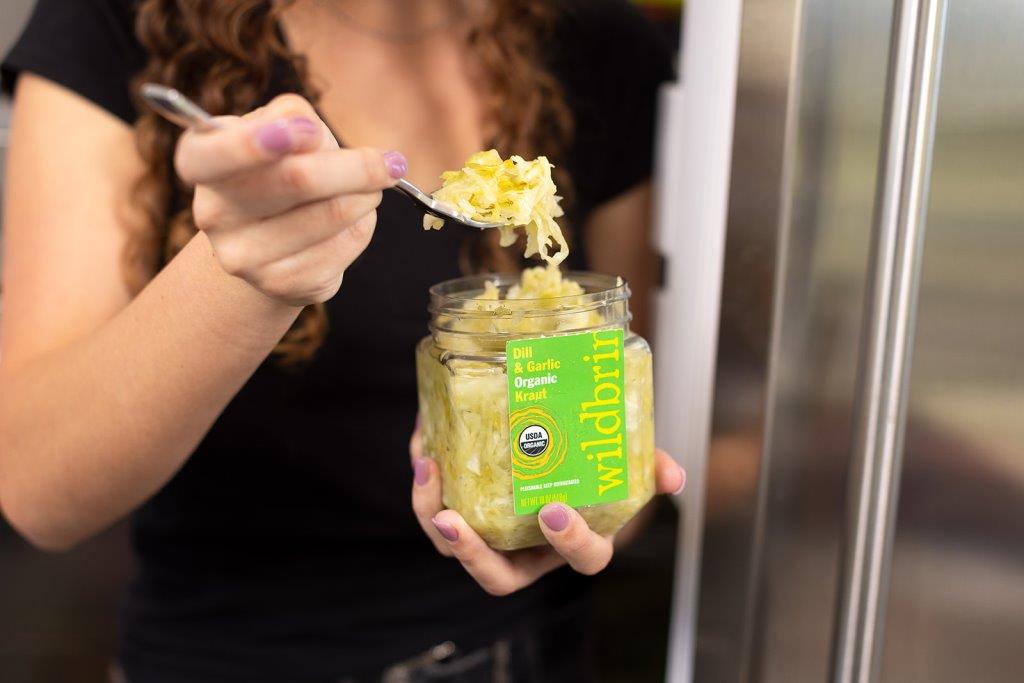What qualifies as “fun” in your book? Jumping out of a moving plane and living to tell the tale? Sunbathing on a tropical beach? Dinner with friends or one friend in particular? How about karaoke? Everybody loves karaoke. Well, maybe not everybody. The point is there are a lot of fun things in the world. So, you probably won’t be surprised to hear we’ve recently become obsessed with a life-changing, add-it-to-absolutely-everything condiment that’s fun to cook with, fun to eat, and fun to talk about. Ready for it? Drumroll please. Our new addiction-worthy edible source of “fun” is – wait for it – sour cabbage (or sauerkraut, as the Germans say). Ok, ok, ok. We know what you’re thinking. Getting excited about fermented cabbage is a tad crazy. We thought so too, until we did a little research and stumbled upon five (count ‘em – one, two, three, four, five) fun facts about sauerkraut.
Fun Facts About Sauerkraut Every Foodie Should Know
Fact #1. Sauerkraut is one of the world’s oldest superfoods.
Ever wonder what Hippocrates, Genghis Khan, Captain James Cook, and Heidi Klum all have in common? If you guessed they all valued (or value) the health benefits of sauerkraut, you guessed right. Rich in nutrients and probiotics and low in calories, sauerkraut is a real-life, bona fide superfood. It’s loaded with fiber, essential minerals, vitamins, and folate – just about everything you need to keep your body and mind functioning properly day in and day out. Best of all, it’s only 30 calories per cup. Could be you’re already familiar with these health-related facts about sauerkraut. After all, this once humble veggie has been garnering a lot of attention of late. Supermodel Heidi Klum recently went on record, crediting her professional success to her grandmother’s homemade sauerkraut soup. And both sauerkraut and its cousin from the Far East, kimchi, have been prominently featured in today’s top-trending, plant-based diets. You might also have noticed the growing number of sweet, sour, and spicy artisan krauts crowding your grocer’s shelves. What you might not realize, though, is that despite its newfound celebrity status, sauerkraut has had a long and storied history spanning several millennia.
Cabbage was one of the first vegetables to be cultivated, around 4,000 BC in China. However, it wasn’t until laborers toiling on the Great Wall some 2,000 years ago needed a source of winter sustenance that the idea of preserving shredded cabbage leaves in rice wine took root. A few centuries later, Mongol marauders led by Genghis Khan swept in, co-opted the knowledge, and carried it off with them as they continued to push westward.
Hearty and wholesome, sauerkraut eventually became a mainstay of Central and Eastern European cuisine and was soon recognized for its medicinal qualities. Ancient physicians relied on the new miracle food for its healing properties, and military leaders carried kegs of it with them to ward off scurvy (if you’ve ever been curious as to how Germans earned the nickname “Krauts,” now you know). Even commonfolk came to rely on sauerkraut for its longevity. The preserved vegetable with its telltale briny flavor was so valued, it was often included in New Year’s celebrations as a sign of good things to come.
In the 18th century, German and Dutch immigrants traveled to the New World, bringing sauerkraut with them and spawning a classic American street food in the process. Even today, no visit to the Big Apple is complete without lining up at a corner pushcart to enjoy a steaming frankfurter smothered in sauerkraut and spicy brown mustard.
Fact #2. The healthiest sauerkraut options contain LIVE cultures!
Not squeamish, are you? Good, because fermentation relies on naturally occurring bacteria (tiny, one-celled microorganisms) to preserve foods and infuse them with a pleasant bitterness and zest. And in turn, those perpetually busy bacteria promote the growth of more helpful bacteria, known as probiotics, that improve your body’s immune function and contribute to your digestive, heart, and mental health. In fact, billions of these friendly microbes reside in your gut helping your body absorb vitamins and minerals, while at the same time fighting off bad bacteria that can lead to disease.
Another of our fun facts about sauerkraut you should tuck away for safekeeping is that the number one enemy of both good and bad bacteria is heat. So, when buying sauerkraut, avoid choosing brands that have been pre-cooked, pasteurized, or canned. Instead, shop for sauerkraut in your market’s refrigerated section and/or order from a wide selection of vegan, gluten-free krauts at wildbrine.com. Be sure to look for labels with the words “raw,” “perishable,” “unpasteurized,” “naturally occurring lactobacilli,” or “naturally fermented” to ensure you’re getting the good stuff – and by “good,” we mean LIVE.
Fact #3. A little sauerkraut goes a long way.
Ever heard the phrase “Too much of a good thing?” Whoever came up with it could have been talking about sauerkraut. As with most probiotic-rich foods, nutritionists recommend starting out slowly when adding sauerkraut to your diet. Too much of this pucker-worthy superfood can cause bloating and flatulence (aka gas) – not a combo you want to fool with. Some brands are also high in sodium, which can increase blood pressure and aggravate heart issues. Don’t let these not-so-fun facts about sauerkraut deter you though. With a little planning and self-restraint, you can comfortably incorporate this ancient miracle food into your diet and begin enjoying its health benefits sooner, rather than later.
First, take the time to shop for low-sodium brands. Draining and rinsing the kraut will reduce sodium levels even further. Second, introduce sauerkraut into your daily meal routine gradually, beginning with 1-2 Tbsp. per day and working your way up to 6 Tbsp. Luckily, it doesn’t take much of this flavor-packed side or garnish to liven up an otherwise hum-drum recipe or to breathe new life into your family’s favorite dish. Don’t believe us? Next time you serve up a burger, sandwich, soup, or salad, top it off with a heap of crunchy spiced kraut slaw and see what happens. Tasting is believing.
Fact #4. Sauerkraut is the star ingredient in a favorite American sandwich whose early 20th century origins are hotly debated.
Do you know what sandwich we’re talking about? How about a hint? Picture layers of thinly sliced corned beef smothered in ooey gooey melted Swiss cheese topped with a generous heap of tangy sauerkraut and a drizzle of creamy Thousand Island dressing – all smushed together between two thick slices of grilled rye bread. The iconic sandwich we’re talking about is the Reuben, a sandwich so insanely delicious, it has its own Wikipedia page. Of course, having its origins shrouded in mystery also adds to its allure. Some give credit to Reuben Kulakofsky, a poker-playing Jewish grocer in Omaha, Nebraska, while others pay homage to Arnold Reuben, the German-Jewish owner of Reuben’s Delicatessen in New York City. We may never know for certain who actually was the first to make this American classic, and frankly, we don’t really care. We’re just glad they did. (P.S. if you’re watching your carbs, try this open-face slider twist on a traditional Reuben sandwich.)
Fact #5. Sauerkraut is featured in the Guinness World Book of Records.
In 2018, Joanna Webster, Katie Venner, and a team of volunteers set the Guinness World Record for making a whopping 792 pounds of sauerkraut in just six hours. That’s a heck of a lot of chopped cabbage, especially considering the average American, according to USDA data, consumes only about 1.3 pounds of sauerkraut annually. We suspect that figure is on the rise though as more and more people are turning to plant-based diets and healthier lifestyle habits. But we’ll have to step up our game considerably if we hope to catch up with our friends in Germany and France, who as reported by germanfoods.org, gobble up 2.6 and 3.75 pounds, respectfully, of the fermented delicacy per person each year.
Luckily, there’s no shortage of cabbage here at home. As we scoured the internet for more facts about sauerkraut, we learned that stats from World Atlas and the Agricultural Marketing Resources Center peg U.S. production of cabbage at approximately 965,000 tons annually, with most coming from five states: California, Florida, New York, Texas, and Wisconsin. And while about 12% is made into sauerkraut, the bulk of U.S. cabbage is transformed into another American picnic food – coleslaw. Cabbage, which comes from the same nutrient-rich plant family as broccoli, cauliflower, and kale, is a healthy food choice no matter how you choose to eat it. But if you’re looking for eye-popping flavor and gut-soothing probiotic benefits, then sauerkraut is the way to go.
Eat it right out of the jar – or don’t. There are so many ways to experiment with and incorporate sauerkraut into to your most well-worn, sought-after recipes. From over-stuffed dumplings, to crispy won tons, to hearty stews and crisp, zesty salads, sauerkraut is the ingredient that just keeps on giving. Even chocolate cake tastes fudgier, denser, and more decadent when it’s made with sauerkraut. So, what do you say? Want to have a little fun? Grab a jar of sauerkraut and dig in!

